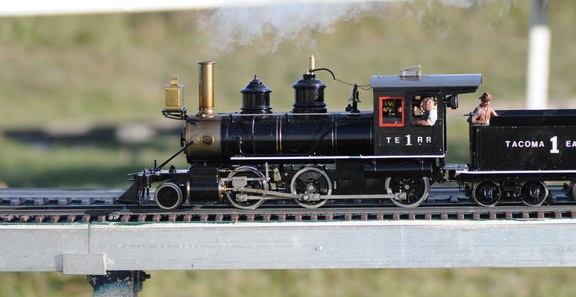A Lionel Christmas: Toy Trains and the Linking of Generations
By Cara Cannella

Model steam train outside Georgetown PowerPlant Museum, Seattle, Washington. Photo by Joe Mabel via WikiMedia.
In the hours before I boarded the school bus for afternoon kindergarten, I often joined my dad at the kitchen table, where he wrote or graded studentsâ papers at one end of the table. I sat facing him, coloring in pictures he had drawn for me, my legs dangling beneath the table. A skilled amateur draughtsman, he created nostalgic black-and-white scenes inspired by real life. In one of our preserved collaborations, a family ice-skates on a purple pond.
Our work created its own little world, with Bob Dylan or The Beatles playing softly in the next room. Like two toddlers engaged in parallel play, we were joined by imagination in our solo missions. On those mornings, I learned the importance of ritual, and that creativity lies in the doing, not the talking.
During this and every Christmas season, Iâm reminded of another little world my dad inhabits in the Connecticut house where I grew up, and which I sometimes join. To get there, he climbs a ladder to the attic full of musty boxes and pulls down those marked âLionel.â
He sets up a wide, wooden platform painted forest green beneath a freshly cut tree and unwraps objects with the emotional weight of old friends. As the model train cars, tiny people, animals, buildings, silos, fences, trees, and other accessories emerge from smudged newsprint wrapping, his face lights up in rekindled surprise. The scent of pine and the feel of cold metal track turning over in his hand must bring him back to December 1949, when he was five years old in Pittston, Pennsylvania, and this Lionel train collection with accompanying village was born as a Christmas gift.
In the memoir Playing With Trains: A Passion Beyond Scale, author Sam Poseyâs life story mirrors my dadâs in ways familiar to many train-obsessed members of their generation. When he was a little boy in the late 1940s, following his fatherâs death in combat in World War II, Poseyâs mother wired a Lionel train layout for him. He describes getting hooked on âa miniature universe which I could operate on my own. Speed and control: I was fascinated by both, as well as by the way they were inextricably bound together.â
The toy train inventor Joshua Lionel Cowen was also a savvy businessman, Posey explains, whose âgreatest strength was that he understood the mythology of the American family.â In the paradigm promoted by his catalogs, Father knows best and watches with loving patience as Son learns how to build a locomotive world.
A quick Google image search of âLionelâ reveals a Norman Rockwell-esque 1951 advertisement depicting a boy in play clothes (dungarees, sneakers, ball cap), Dad in an after-work sweater vest, Mom in a dress and heels, and the family dog overseeing a train layout beneath the Christmas tree. The text reads:
Lionel Trains make a Boy feel like a Man
and a Man feel like a Boy
Everybody is Happy when it's a Lionel Train Christmas
I canât say thatâs always been true in my family, but Iâve learned a lot from and about my dad in watching him engage completely with a lifelong pleasure, even if it's an escape I don't fully understand. In observing his concentration as he tinkers with details of a timeless village (in a recent development, a round makeup mirror doubles as a pond for inch-high ice-skaters) and deals with faulty, sparking tracks and derailed train cars, Iâm reminded of what it is to be completely absorbed in a gratifying activity. The passion, challenge, and intrinsic reward that drive Poseyâs Playing With Trains and my dadâs creative world have added so much color to mine.
